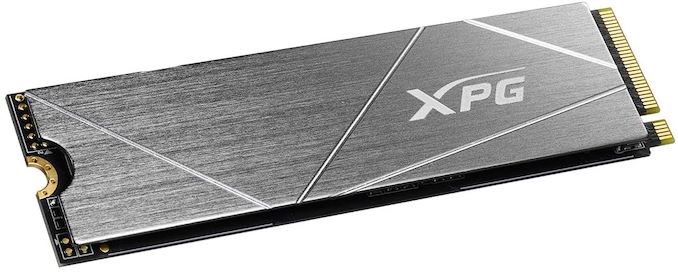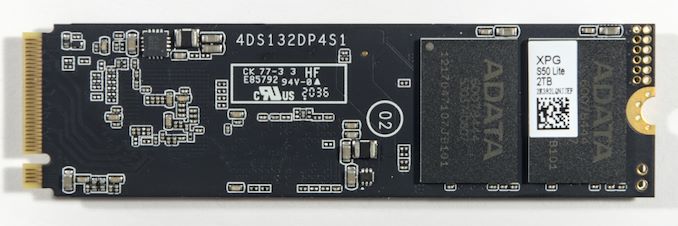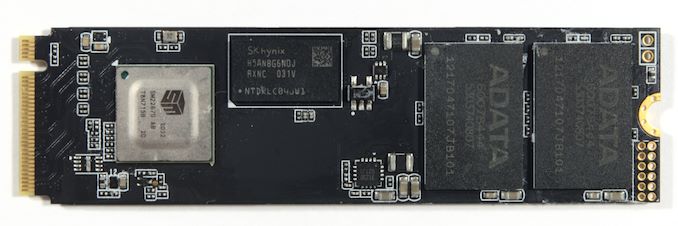The ADATA GAMMIX S50 Lite 2TB SSD Review: Mainstream PCIe Gen4
by Billy Tallis on April 30, 2021 8:00 AM EST
The roll-out of PCIe 4.0 support to consumer NVMe SSDs has been a long, drawn-out process so far, but it is progressing. Two waves of high-end SSDs have now hit the market, and last year we saw several brands introduce QLC-based SSDs using the now-outdated first-wave Gen4 SSD controller from Phison. More recently, PCIe 4.0 support has arrived for the mainstream mid-range market segment thanks to the ADATA XPG Gammix S50 Lite, based on the Silicon Motion SM2267 controller and TLC NAND flash memory.
The ADATA S50 Lite uses Silicon Motion's first PCie 4.0 SSD controller: the SM2267. Opting to start small, Silicon Motion has launched their mainstream SSD controller first, while their upcoming (overdue?) SM2264 will eventually be filling the high-end role.
To that end, the SM2267 serves Silicon Motion's lineup as a smaller, cheaper design aimed at mainstream consumer use cases. To accomplish this, Silicon Motion has built the SM2267 on a tried-and-true (and cheap) 28nm process and equipped the controller with 4 NAND channels, as opposed to the 12nm (or smaller) 8-channel controllers that are used in the latest high-end drives. This does limit maximum performance, but it also helps to keep costs in check, something that's especially useful during the current chip crunch.
Intel's recently-launched third generation QLC SSD (the Intel SSD 670p) uses a close relative of this controller; the SM2265 is an Intel-commissioned derivative of the SM2267 that lacks PCIe 4.0 support, but is otherwise identical in all the important ways. As we'll see from the S50 Lite's performance, the Intel 670p isn't missing out on much without that Gen4 support.
As for the subject of today's review, the ADATA XPG Gammix S50 Lite and its SM2267 controller is part of a growing trend of mainstream NVMe SSDs moving to 4-channel controllers rather than 8 channels. The capacity of individual NAND flash memory dies has grown to the point that an 8-channel controller is not necessary to get 2TB of flash connected, and the IO speed of recent generations of NAND flash is fast enough that a newer four-channel controller can match the performance of older 8-channel designs. This was first demonstrated to great effect by the SK hynix Gold P31. On paper, the Gammix S50 Lite promises more or less the same thing: performance that matches or slightly exceeds what we see from high-end PCIe Gen3 SSDs also using TLC NAND, despite working with half as many NAND channels.
| ADATA XPG Gammix S50 Lite Specifications | |||||
| Capacity | 512 GB | 1 TB | 2 TB | ||
| Form Factor | M.2 2280 double-sided with heatsink | ||||
| Interface | PCIe 4 x4, NVMe 1.4 | ||||
| Controller | Silicon Motion SM2267 | ||||
| NAND Flash | Intel/Micron 96L TLC | ||||
| DRAM | DDR4 | ||||
| Sequential Read (MB/s) | 3800 | 3900 | |||
| Sequential Write (MB/s) | 2800 | 3200 | |||
| Random Read IOPS (4kB) | 191k | 380k | 490k | ||
| Random Write IOPS (4kB) | 510k | 540k | |||
| Warranty | 5 years | ||||
| Write Endurance | 370 TB 0.4 DWPD |
740 TB 0.4 DWPD |
1480 TB 0.4 DWPD |
||
| Retail Price | $139.99 (14¢/GB) |
$235.99 (12¢/GB) |
|||
ADATA equips the S50 Lite with a fairly thick heatspreader, and like most of their Gammix SSDs, that heatspreader comes already attached to the drive rather than packaged separately as with their SX series drives. Instead of using their typical thermal paste, this heatspreader is attached with what is by far the most tenacious thermal tape we've ever encountered. It is reinforced with a tight-woven stiff fabric and the adhesive was strong enough that removing the heatspreader without permanently damaging the drive required copious use of solvents instead of just a bit of gentle prying.
So while we had originally speculated that the SM2267 controller might allow the S50 Lite to be the first Gen4 SSD suitable for laptop usage (hoping for similar power efficiency to the SK hynix Gold P31), this heatspreader plus the double-sided design means the S50 Lite will be a challenge to fit into some notebooks.
The SM2267 controller actually has a slightly higher pin count than the older 8-channel SM2262(EN) controllers, but the SM2267 uses denser packaging to fit in the same footprint as their earlier 4-channel SM2263 controller. The resulting PCB layout is not at all crowded, and could have easily been made into a single-sided design like the Intel 670p, had ADATA wanted to stack 16 NAND dies per package. Any future drives that use the DRAMless SM2267XT variant certainly should be single-sided.
Our 2TB S50 Lite sample is equipped with 1GB of DDR4 DRAM—half as much as we would typically expect from a mainstream or high-end SSD. As the high-end has moved on to PCIe Gen4, we have seen an increasing number of mid-range or low-end NVMe SSDs cut back from the usual 1GB per 1TB ratio of DRAM to NAND, and with the S50 Lite that trend has crossed over to Gen4. Having half or a fourth of the usual DRAM is nowhere near as serious a handicap as an entirely DRAMless SSD design, and will generally only make a difference for very storage-intense usage with heavy multitasking—workloads that are a bit beyond the intended use case for a drive like the S50 Lite.
Also noteworthy about the S50 Lite is that ADATA announced and published specs for a 512GB model, but we've only seen the 1TB and 2TB models hit the market.
The Competition
ADATA's original Gammix S50 was a Phison E16 drive: their first flagship Gen4 drive and part of the first wave of consumer Gen4 SSDs. That has since been superseded by the Gammix S70, and the S50 Lite slots into a lower position in their product stack. Standing in for the various Phison E16 TLC drives, we have test results from the Seagate FireCuda 520. We also have the Corsair MP600 CORE representing the Phison E16 QLC drive family.
Other PCIe Gen4 drives in this review include the WD Black SN850 and Samsung 980 PRO—both high-end models that are significantly more expensive.
The rest of the drives included in this review are a variety of more mainstream PCIe Gen3 SSDs and some relatively low-end NVMe options. Highlights include the Intel 670p (almost the same controller, but with QLC), the HP EX950 and Kingston KC2500 using the previous-generation SM2262EN controller, and Microcenter's Inland Premium representing the current crop of Phison E12S drives with TLC NAND and a reduced DRAM ratio.

















93 Comments
View All Comments
Scour - Friday, April 30, 2021 - link
Yep, it makes no sense use PCIe 4.0 for a drive which is not fast enough to reach the PCIe 3.0-max speedsMrCommunistGen - Friday, April 30, 2021 - link
Most B550 boards have 2x M.2 slots, with the main slot being 4.0 and connected to the CPU and the second slot hanging off the chipset and limited to 3.0 speeds. So... plug it into the 2nd slot and leave the 1st slot for a higher performance 4.0 drive if you have one?X570 avoids this by having 4.0 lanes off of the chipset, so take your pick on which slot to plug it into. Probably wouldn't hurt to plug the higher performance drive into the CPU lanes.
Future buyers may get different hardware, but at least today based on the reviewed hardware and the price of the product this drive looks like it has pretty decent value.
In most of the tests it seems to rival the 970 EVO Plus which is a decent bit more expensive. After the SLC cache runs out, performance is definitely lower, but most average consumers aren't writing hundreds of GB of data at a time and should stay within the cache most of the time.
Nagorak - Friday, April 30, 2021 - link
I wish the reviewers did a bit better job at explaining what the average person actually needs in terms of performance. Yes, they do all kinds of different tests which are admirable, but what does it mean in the end to the average user?Maybe the truth is that most people wouldn't be able to tell the difference between the fastest SSD on the market and a SATA SSD, so it literally doesn't matter.
GeoffreyA - Sunday, May 2, 2021 - link
Techpowerup has a few real-world numbers that might be useful. Different model though.https://www.techpowerup.com/review/adata-xpg-gammi...
FunBunny2 - Thursday, May 6, 2021 - link
"Yep, it makes no sense use PCIe 4.0 for a drive which is not fast enough to reach the PCIe 3.0-max speeds"yeah, but... I'll bet lots o folks will gladly spend twice as much for a '5G' phone that can, at best, run sub-6 in a few locations and mmWave only in some sports arenas so they can watch the game they've paid a bunch to sit in the seat, on that phone. a fool and his money is soon parted.
utroz - Sunday, May 2, 2021 - link
The 2 advantages of using PCIe 4.0 x4 is that it can still get the same speed as a PCI-e 3.0 x4 on slots that support PCIe 4.0 x2 and if you use a PCIe 3.0 x4 slot you shouldn't loose much if any performance (just cause this drive is kinda slow for PCIe 4.0).ozark - Friday, April 30, 2021 - link
The good ol' "Fool me once..."I was recommending the S8200 pro to several friends, even bought one myself around Thanksgiving last year. Turned out I got the "in-between" version with slightly lower performance. I wouldn't mind buying it at all if they were just honest with part switch since paying for $110 for above-average 1TB NVME SSD is still a pretty good deal.
No way I'll buy ADATA SSD again though...
FerroMagnetar - Friday, April 30, 2021 - link
To this day I always try to buy MLC drives, though I know their days are numbered :(Nexing - Saturday, May 1, 2021 - link
At 2021 I am quite lost in this. Which MVME 1TB MLC drives, fast and below $150-200 exist?Thank you
crimson117 - Friday, April 30, 2021 - link
"The pricing for the Gammix S50 Lite is unimpressive but also unsurprising"Actually I thought the pricing was one of the main things going for it. It's one of the cheaper good-performing 2TB NVME drives you can buy.
In your chart it's basically tied for second lowest price.